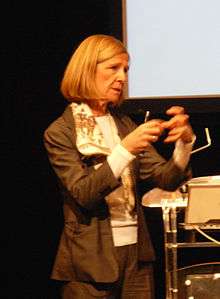Pascale Cossart
| Pascale Cossart | |
|---|---|
 Pascale Cossart during the conference | |
| Born | 21 March 1948 |
| Fields | Bacteriology |
| Institutions | Pasteur Institute |
| Alma mater | Lille University, Georgetown University, University of Paris |
Pascale Cossart (born 21 March 1948) is a bacteriologist at the Pasteur Institute of Paris, and the foremost authority on Listeria monocytogenes,[1] a deadly and common food-borne pathogen responsible for encephalitis, meningitis, bacteremia, gastroenteritis, and other diseases.
Biography
Cossart earned a B.S. and M.S. from Lille University in 1968. She then earned an M.S. in chemistry from Georgetown University in 1971, and her Ph.D. in biochemistry at the Pasteur Institute and the University of Paris in 1977 (University Paris Diderot).[2] She completed her postdoctoral fellowship at the Pasteur Institute.[2] She is currently a Professor and Head of the Unité des Interactions Bactéries Cellules at the Pasteur Institute.[2] In 1998, she received the Richard Lounsbery Prize and the L'Oreal-UNESCO Award for Women in Science.[2] She was awarded the Balzan Prize for Infectious Diseases: Basic and Clinical Aspects in 2013.[3]
Works
Cossart's research has focused on infection by intracellular bacteria, and in particular the infectious agent Listeria monocytogenes.[2]
Listeria is a food-borne bacterial pathogen responsible for numerous illnesses and a mortality rate of 30%. The bacteria is one of the best models of intracellular parasitism because it is particularly hardy, able to survive in a variety of cells, cross multiple host barriers, and spreads through ActA, the protein responsible for actin-based motility.[4] Cossart's work has shed light on the genetic and biochemical processes that make Listeria so effective and lethal, identifying the bsh gene; regulatory mechanisms such as an RNA thermosensor that control expression of the virulence genes such as bsh; and the ways in which Listeria enters cells and crosses physiological barriers such as the blood–brain barrier, the intestinal barrier, and the placental barrier. The discovery by Cossart's lab of the interaction between L. monocytogenes' protein, internalin, and its cell receptor, E-cadherin, was the first such study that successfully demonstrated the molecular mechanism that permits a bacterial agent to cross the placental barrier.
In 2009 Cossart published what she describes as the first "bacterial operon map"—the transcriptional program that regulates Listeria's behavior in different environmental conditions.[5] By comparing the sequences of Listeria drawn from soil and drawn from the human gut, Cossart identified non-coding RNAs that contribute to Listeria's virulence, identified additional RNA repressors, and determined that riboswitches can act both downstream and upstream.
As part of her work she has also developed important biological tools, including a transgenic mouse that was the first animal model to overcome bacterial species-specificity. The mouse carried a human version of a host cell membrane receptor that L. monocytogenes used to enter cells.
Significant publications
- Cellular Microbiology, 2nd Ed. (textbook), edited by Pascale Cossart, Patrice Boquet, and Staffan Normark
- Science June 1, 2001
- Nature, May 17, 2009
Awards, prizes, and honorary lectures
- Carlos J. Finlay Prize for Microbiology (1995)
- Richard Lounsbery Award (1998)
- Helena Rubenstein / UNESCO Award for Women in Science Leadership (1998)
- Officier de la Légion d'Honneur and Officier de l'Ordre du Merite, French Legion of Honor
- Louis Pasteur Gold Medal (2000), Swedish Society of Medicine
- Valade Prize (2003), Fondation de France
- Margaret Pittman Lecture, National Institutes of Health (2003)
- President, Conseil Scientifique of the Pasteur Institute
- Corresponding member, French Academy of Sciences
- Member, French Conseil National de la Science
- Member, American Academy of Microbiology
- Member, German Academy of Sciences Leopoldina
- Robert Koch Prize (2007)
- Foreign member, Royal Society of London (2010)
- Balzan Prize 2013
References
- ↑ Caitlin Sedwick, "Pascale Cossart: The ins and outs of Listeria" (interview), JCB, v.192, n.6, pp.904-905 (March 21, 2011).
- 1 2 3 4 5 "Pascale F. Cossart, PhD". Howard Hughes Medical Institute. Retrieved 19 April 2016.
- ↑ "The Balzan Prizewinners 2013". International Balzan Prize Foundation. 9 September 2013. Retrieved 19 April 2016.
- ↑ "Pascale Cossart", ASCB Newsletter, Dec. 2006, pp.32-34.
- ↑ Nature, May 17, 2009.